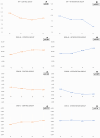A transitional care program in a technologically monitored in-hospital facility reduces the length of hospital stay and improves multidimensional frailty in older patients: a Randomized Clinical Trial
- PMID: 39105934
- PMCID: PMC11303417
- DOI: 10.1007/s40520-024-02821-8
A transitional care program in a technologically monitored in-hospital facility reduces the length of hospital stay and improves multidimensional frailty in older patients: a Randomized Clinical Trial
Abstract
Background: Longer length of hospital stay (LOS) negatively affects the organizational efficiency of public health systems and both clinical and functional aspects of older patients. Data on the effects of transitional care programs based on multicomponent interventions to reduce LOS of older patients are scarce and controversial.
Aims: The PRO-HOME study aimed to assess the efficacy in reducing LOS of a transitional care program involving a multicomponent intervention inside a technologically monitored in-hospital discharge facility.
Methods: This is a Randomized Clinical Trial on 60 patients (≥65 years), deemed stable and dischargeable from the Acute Geriatrics Unit, equally assigned to the Control Group (CG) or Intervention Group (IG). The latter underwent a multicomponent intervention including lifestyle educational program, cognitive and physical training. At baseline, multidimensional frailty according to the Multidimensional Prognostic Index (MPI), and Health-Related Quality of Life (HRQOL) were assessed in both groups, along with physical capacities for the IG. Enrolled subjects were evaluated after 6 months of follow-up to assess multidimensional frailty, HRQOL, and re-hospitalization, institutionalization, and death rates.
Results: The IG showed a significant 2-day reduction in LOS (median days IG = 2 (2-3) vs. CG = 4 (3-6); p < 0.001) and an improvement in multidimensional frailty at 6 months compared to CG (median score IG = 0.25(0.25-0.36) vs. CG = 0.38(0.31-0.45); p = 0.040). No differences were found between the two groups in HRQOL, and re-hospitalization, institutionalization, and death rates.
Discussion: Multidimensional frailty is a reversible condition that can be improved by reduced LOS.
Conclusions: The PRO-HOME transitional care program reduces LOS and multidimensional frailty in hospitalized older patients.
Trial registration: ClinicalTrials.gov n. NCT06227923 (retrospectively registered on 29/01/2024).
Keywords: Comprehensive Geriatric Assessment; Multidimensional Prognostic Index; Multidimensional frailty; Transitional care program.
© 2024. The Author(s).
Conflict of interest statement
The authors declare no competing interests.
Figures

References
-
- Freeman WJ, Weiss AJ, Heslin KC (2018) Statistical Brief# 246: Overview of US hospital stays in 2016: variation by geographic region. Agency for Healthcare Research and Quality - PubMed
-
- Patrone C, Cella A, Martini C et al (2019) Development of a smart post-hospitalization facility for older people by using domotics, robotics, and automated tele-monitoring. Geriatr Care 5:12–17. 10.4081/gc.2019.812210.4081/gc.2019.8122 - DOI
Publication types
MeSH terms
Associated data
Grants and funding
LinkOut - more resources
Full Text Sources
Medical

